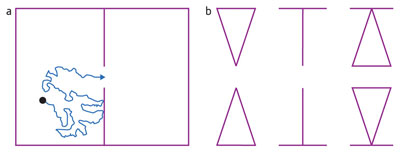| Posted: March 5, 2010 |
The geometry of randomness |
|
(Nanowerk News) When a butterfly flaps its wings in Europe, a storm may be caused in Asia. This often-used metaphor illustrates the strong resonances that may occur in random physical systems. Indeed, in systems affected by random effects, the influence of stimuli, such as external forces, on the eventual outcome is often poorly understood. An international team of researchers working at the RIKEN Advanced Science Institute in Wako has now discovered that geometric factors can play an important role in random processes such as the movement of a particle through a cell membrane ("Geometric Stochastic Resonance").
|
|
One particular consequence of random effects is stochastic resonance, where the movement of an object between two states—for example, across a membrane partitioning a box—depends on the external force, or ‘noise’ applied to the system. Certain levels of noise may even amplify the response of the system, so that the particle in the box travels faster from left to right. “Stochastic resonance is a common effect in electrical circuits or in biological sensory organs, where it is used to increase the system’s response,” says Franco Nori, who led the research team.
|
 |
| Figure 1: An illustration of stochastic resonance. (a) The path of the ‘random walk’ of a particle in a box with a partition that has one pore. (b) Three different geometries of the pore will have three different influences on the transfer of the particle across the membrane when an oscillating external field is applied to the system.
|
|
Stochastic resonance is a purely random effect, although the size and shape of a variety of constrained biological systems, such as pores or channels, can influence the response of the system, according to team member Pulak Kumar Ghosh.
|
|
The researchers therefore studied the influence of geometrical effects on stochastic resonance (Fig. 1). “We considered systems where the membrane has different pore geometries,” says Fabio Marchesoni, also from the team. In order to stimulate a geometric response, the researchers simulated the effect of an oscillating force perpendicular to the membrane that shakes the particles back and forth. Previous studies of stochastic resonance effects showed that a force that produces no net movement should have no influence on the particle transport. Yet, Nori and colleagues observed a strong influence on the frequency of the driving force as well as its amplitude. In addition, the shape of the membrane and that of the surrounding cavities plays a role in the efficiency of the particle transfer.
|
|
Owing to the geometric dependence of this effect, the researchers have coined it ‘geometric stochastic resonance’, and expect to find it in certain physical systems. Team member Sergey Savel’ev suggests that, “the transport of magnetic fields across superconducting samples with thin barriers may be a good first experimental example that demonstrates geometric stochastic resonance.”
|

